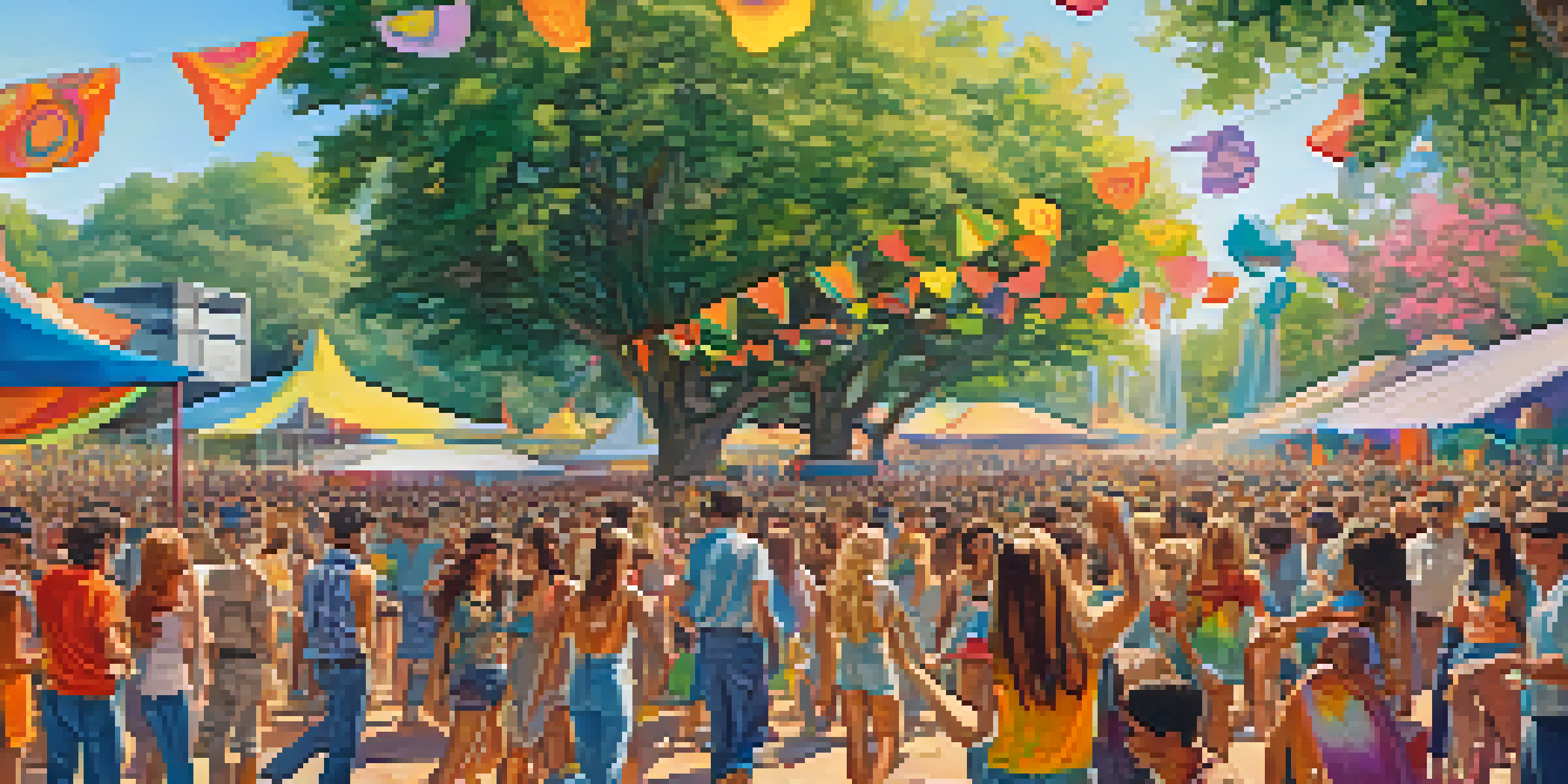The Cultural Impact of Marijuana During the 1960s Counterculture

The 1960s: A Decade of Change and Rebellion
The 1960s were a pivotal time in history, marked by social upheaval and cultural transformation. The youth of this era began questioning traditional norms and authority, seeking alternative lifestyles and self-expression. This rebellious spirit laid the groundwork for a counterculture movement that sought freedom, peace, and love.
The drug is a great tool for self-exploration, but it’s not the only tool. You’ve got to learn how to use it wisely.
Amidst the backdrop of civil rights movements and anti-war protests, marijuana emerged as a symbol of this liberation. It represented a break from conformity and an embrace of new ideas, often associated with the hippie movement. The drug's use became a communal experience, fostering connections among those who sought to challenge societal expectations.
As music festivals and gatherings became popular, marijuana played a central role in these events, enhancing the sense of community and shared experience. Classic songs of the era often referenced the drug, intertwining it with the cultural fabric of the time. The 1960s truly marked a significant shift in how society viewed marijuana and its place within the counterculture.
Marijuana as a Catalyst for Artistic Expression
Art and music flourished during the 1960s, with marijuana often cited as a catalyst for creativity. Many artists, musicians, and writers embraced the drug, claiming it expanded their minds and helped them tap into deeper levels of inspiration. This led to an explosion of new sounds and styles, from psychedelic rock to abstract art.

Iconic bands like The Beatles and The Grateful Dead infused their work with themes of love, peace, and transcendence, often under the influence of marijuana. Their music resonated with a generation that craved change and self-discovery, creating an enduring legacy that still influences artists today. The visuals of the era, marked by vibrant colors and surreal imagery, mirrored the heightened perceptions that users often experienced.
Marijuana as a Symbol of Rebellion
In the 1960s, marijuana became a symbol of the counterculture movement, representing a break from conformity and a quest for freedom.
This artistic revolution was not limited to music; literature and visual arts also embraced marijuana as a means to challenge conventional boundaries. Writers like Jack Kerouac and Allen Ginsberg explored consciousness and society through their works, paving the way for future generations of creatives. In this way, marijuana became more than just a drug—it was a tool for exploring the human experience.
The Role of Marijuana in Activism and Protest
Marijuana was not just a recreational substance; it also became a symbol of resistance during various social movements in the 1960s. Activists used it to challenge the status quo and advocate for broader freedoms, arguing that its prohibition was an infringement on personal liberties. This perspective helped to galvanize support for various causes, including anti-war and civil rights movements.
The only thing that matters is how you feel about yourself and what you’re doing.
The legalization of marijuana was championed by many as part of a larger fight against government control and societal oppression. This fight resonated deeply with those who sought social justice and equality. By aligning marijuana use with these causes, advocates added another layer to its cultural significance during the decade.
Protests often included marijuana as a statement of defiance, with public demonstrations and gatherings promoting its use openly. The combination of music, art, and activism created a vibrant tapestry of resistance that defined the counterculture. As a result, marijuana became a potent symbol of not just rebellion, but also unity among those fighting for change.
Changing Perceptions: From Taboo to Acceptance
Before the 1960s, marijuana was largely viewed as a taboo subject, often associated with criminal activity. However, as the counterculture movement gained momentum, public perceptions began to shift. The widespread use of marijuana among influential figures and artists helped to destigmatize its use and promote it as a legitimate means of self-exploration.
With the rise of the hippie movement, marijuana was increasingly seen as a tool for peace and love rather than just a drug. This rebranding allowed many to embrace it as part of their identity, challenging the negative stereotypes that had long surrounded its use. The cultural narrative began to pivot, with marijuana positioned as a natural element of the burgeoning counterculture lifestyle.
Catalyst for Creativity and Art
Marijuana played a significant role in the artistic revolution of the 1960s, inspiring musicians and writers to explore new forms of expression.
This transformation was not without controversy, as conservative factions pushed back against the changing views. Nonetheless, the 1960s marked a significant turning point in how society approached marijuana, setting the stage for future conversations around its legalization and acceptance. It became a symbol of the evolving moral landscape of America during a time of significant change.
The Influence of Marijuana on Fashion and Lifestyle
The counterculture of the 1960s extended beyond music and politics; it also permeated fashion and lifestyle choices. The embrace of marijuana was mirrored in the clothing styles of the era, with tie-dye shirts, bell-bottoms, and flowing garments becoming symbols of the hippie movement. These fashion choices reflected ideals of freedom, individuality, and nonconformity.
Lifestyle changes were also evident, as many young people adopted alternative living arrangements, such as communal living and organic farming. These practices often included the cultivation and use of marijuana, reinforcing its role in promoting a holistic and natural approach to life. The ethos of 'peace and love' became a cornerstone of this lifestyle, with marijuana serving as a bonding element in these communities.
As the counterculture gained visibility, so did its influence on mainstream fashion and lifestyle trends. Designers began to draw inspiration from the vibrant aesthetics of the movement, bringing elements of this culture into the broader fashion landscape. This fusion of styles further solidified marijuana's impact on the cultural zeitgeist of the 1960s.
Marijuana's Legacy in Modern Culture
The cultural impact of marijuana during the 1960s has left a lasting legacy that continues to influence modern society. Today, we see a growing acceptance of marijuana, with many states legalizing its use for both medicinal and recreational purposes. This shift can be traced back to the conversations and movements sparked during the counterculture era.
The music, art, and literature from the 1960s have endured, inspiring subsequent generations to explore themes of freedom and self-expression. The message of peace and love, often associated with marijuana, remains relevant as social justice movements continue to thrive. In many ways, marijuana has become a symbol of the ongoing quest for personal and societal liberation.
Changing Views on Marijuana
The 1960s marked a transformative period where marijuana shifted from being a taboo subject to a symbol of peace and acceptance in society.
As we look at the modern landscape, it's clear that the counterculture of the 1960s has shaped attitudes toward marijuana, fostering a more open dialogue about its benefits and risks. The evolution of these perceptions highlights how culture can drive change, paving the way for a more nuanced understanding of marijuana's role in society today.
The Future of Marijuana in Society and Culture
Looking ahead, the future of marijuana in society and culture appears bright, with continued trends toward legalization and acceptance. As more research emerges about its medicinal benefits, we can expect to see further integration into healthcare discussions. This acceptance marks a significant shift from the stigma of previous decades, reflecting broader societal changes.
Culturally, marijuana is likely to remain a point of inspiration for artists and musicians, continuing the legacy established in the 1960s. As new generations embrace its use, they will likely incorporate it into their expressions of identity and community. This ongoing dialogue will keep the spirit of the counterculture alive, adapting it to modern contexts and challenges.

Moreover, as the conversation surrounding marijuana evolves, it will be essential to address issues of equity and access. The lessons learned from the 1960s can guide us in creating a more inclusive industry that honors the roots of the counterculture. In this way, marijuana can continue to be a force for social change and cultural expression in the years to come.